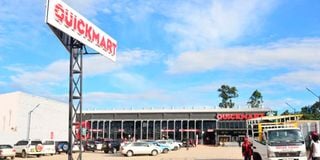Retail real estate shows improved performance despite growth in e-commerce

The Quickmart Supermarket branch at Ongata Rongai in Kajiado County. A review of 2022 shows that major local and international retailers embarked on rapid and aggressive expansion campaigns.
What you need to know:
- The growth of online shopping still poses the biggest threat to the sector's full recovery.
- The Covid-19 pandemic resulted in a major shift to e-commerce, with people preferring to order products online, rather than visit stores.
- The total number of outlets opened this year alone by local and international retailers in major towns across the country stands at more than 100.
Despite the uncertainty triggered by the resurgence of the Covid-19 pandemic, the heated political environment, as well as the rising cost of living, Kenya has witnessed significant growth in the retail real estate space this year.
A review of 2022 shows that major local and international retailers embarked on rapid and aggressive expansion campaigns.
A recent study by Deloitte estimates the total number of outlets opened this year alone by local and international retailers in major towns across the country stands at more than 100.
As retailers moved to capitalise on aspects such as improved road infrastructure which would enable them to access more customers, developers worked on constructing more retail spaces to meet growing demand while increasing their rental yields.
Rapid urbanisation and increased consumer purchasing power, which drove up the demand for goods and services also led many retailers to expand their operations.
“Tenants are willing to pay a premium for buildings located near business centres, transportation hubs and entertainment venues. As such, buildings in metropolitan areas usually have higher rental rates and lower vacancies than those in less populated areas,” noted Deloitte.
Supermarkets' expansion
Notable expansions came from retailers such as Naivas, who increased the number of outlets by five, bringing the total number of operating Naivas outlets in the country to 86.
Meanwhile, QuickMart supermarket opened three new stores in Nairobi and Kitengela to bring its total number of outlets to 53.
Chandarana Food Plus also expanded, opening a new outlet in Nairobi’s Westlands area, bringing the total of its outlets to 25, with plans to open four new outlets in the country soon.
An in-depth study by real estate company Cytonn on the retail real estate market performance reveals that several other smaller retail outlets also embarked on aggressive expansion campaigns.
Eye-wear retailer Optica opened four new outlets in Kitengela, Imaara Mall, Kilimani, and Ruiru, bringing its total number of operating outlets in the country to 62.
Eat’N’Go Limited, an international fast food chain, opened a new eatery in Nairobi, bringing its total operating outlets in the country to nine.
Chicken Cottage, a UK fast-food chain, announced a partnership deal with Express Kitchen to open 50 outlets at Hass Petroleum’s service stations in Kenya, Rwanda, Tanzania and Uganda this year.
Earlier this year, the franchisee for the Domino’s Pizza, Cold Stone Creamery, and Pinkberry Gourmet Frozen Yoghurt brands, also announced plans to open 100 new stores in Kenya, beginning with Nanyuki, Kisumu, Eldoret, and Nakuru towns.
Simbisa Brands, which runs quick-service restaurants such as Chicken Inn, Pizza Inn, Bakers Inn, and Creamy Inn, announced plans to open 55 new outlets by the end of the year.
This will bring the total number of Chicken Inn, Pizza Inn, Bakers Inn and Creamy Inn outlets across the country to 245.
ChicKing, an international fast food chain, in partnership with M/s Crispy Limited, a local franchise, announced plans to open 30 new outlets in Kenya, over the next five years.
Other developments currently underway include the Ojijo Mall in Westlands and Beacon Mall in Nairobi’s CBD.
“Positive demographics and Kenya’s relatively high urbanisation and population growth rates have continued to drive demand for goods and services which trickles down to the demand for more retail spaces,” noted the report.
High demand
The demand and competition for prime retail space have been so high, that shortly after financially troubled retailers vacate, other retailers have quickly moved in to occupy the left spaces.
This has been witnessed where retailers such as Naivas, QuickMart, Carrefour and Eat’N’Go have taken up spaces previously occupied by exiting retailers such as Tuskys and Nakumatt supermarkets.
“The aggressive expansion moves by some of the retailers who are also taking up space previously occupied by troubled retailers have continued to cushion the sector against dwindling occupancy rates and poor performance,” notes Cytonn.
This increased uptake of the retail spaces by retailers in an effort to gain and maintain their market popularity and footprint has in turn contributed to an increase in rental yields from the retail real estate sector.
In the year 2022, the average rental yields obtained from retail spaces in major towns across the country were much higher compared to those obtained in previous years.
At an average of 7.8 per cent for low-market areas, and up to 10 per cent for up-market areas, the rental yields obtained from the retail real estate space were much higher even compared to those obtained from formerly lucrative commercial real estate segments such as office spaces.
International investor interest
Indeed, the increase in the number of retail outlets and by extension rental yields obtained has consequently spiked local and international investor interest in the sector.

Naivas Supermarket on Eastern Bypass in this picture taken on May 12, 2021.
Investor confidence has also been enhanced by the country’s favourable trading policies, especially friendly for large investors who pay lesser taxes relative to the returns obtained from their investments.
“Kenya currently ranks at position 56 in terms of ease of doing business as of 2019 according to the World Bank. This is compared to position 113 five years ago. The improvement has driven more expansion activities and developments in the country thereby initiating the growth of the sector,” noted Cytonn.
This, coupled with Kenya’s recognition as a regional trading hub worldwide has attracted many international organisations and retailers into the country who have continued to increase the demand for retail space in the country.
“We expect the retail sector to continue witnessing rapid development activities which in turn boost its performance driven by the aggressive expansion by retailers in the country, rapid infrastructure developments such as roads which promote investments through accessibility and boosting prices, ease of doing business in the country, and rapid population and urbanisation growth rates driving demand for goods and services,” noted the report.
Though the sector witnessed tremendous growth this year, with signs of even better performance in future, financial services firm Deloitte notes that the growth of e-commerce still poses the biggest threat to the full recovery and optimum performance of the commercial retail real estate sector.
“As consumers opt for e-commerce over traditional brick and mortar businesses, we estimate that by the year 2025, a lot of retail properties could remain vacant,” notes Deloitte.
Covid-19 factor
The Covid-19 pandemic resulted in a major shift to e-commerce, with people preferring to order products online, rather than visit stores.
With no customers forthcoming, and unable to meet rent, many small retailers had to fold or shift online.
This consequently resulted in the highest level of vacancy rates ever recorded in malls.
Slow-moving consumer goods retailers especially felt the brunt of the pandemic.
Landlords had to make do with the departure of heavy-hitting tenants, alongside a delay in rent from smaller retailers.
The shift to e-commerce also created an oversupply of retail spaces.
Urban cities such as Nairobi and Kisumu continue to remain oversupplied at 3 million and 0.2 million square feet respectively, thereby forcing developers to halt their plans awaiting the absorption of the existing spaces.
A lot of in-person retail activity has since resumed, offering both landlords, developers and investors a reprieve and an opportunity to reshape their retail real estate fortunes.
Other factors such as high costs related to construction and maintenance of the properties however also continue to weigh down the optimum performance of the sector and prevent it from reaching its full potential.
The increased building cost continues to discourage potential development in the sector due to the overall high cost of construction materials such as steel and cement.
“It is difficult, especially for smaller players, to establish a solid foothold in the real estate markets because of high capital requirements necessary to acquire, develop and maintain properties.”
Real estate costs
Depreciation and amortization also account for a large portion of the real estate costs.
Real estate properties experience annual wear and tear or loss of utility. General administration also makes up a decent amount of expenses incurred throughout the year for firms.

The Quickmart Supermarket Westlands branch before it opened as pictured on March 29, 2022. The retail chain has been on a wide expansion plan opening up branches within and also on the outskirts of the city.
There is also a lack of financing to develop these projects, a factor that impedes the growth of the sector.
Even though retail real estate projects are highly capital intensive, they also offer very high returns.
Due to the risky nature of such investments, however, many financial institutions tend to shy away from lending to the sector.
Indeed, data from the Central Bank of Kenya shows that in the first quarter of the year 2022, the overall non-performing loans in the real estate sector increased by 11.3 per cent from Sh70.5 billion recorded in the first quarter of 2021 to Sh78.5 billion.
“Access to adequate credit has remained a challenge, given the increasing loan default rates in the property sector as financial institutions such as commercial banks continue to tighten their lending terms.”
Moving forward, with consumer spending dramatically reallocated to e-commerce platforms, Deloitte notes that much of the future of retail real estate shall rest on how the sector adjusts to the advancements in technology.
To compete in the current economic environment, developers, investors and retailers shall therefore have to optimise retail spaces to account for the blur between physical and digital retail, since many consumers have come to prefer the convenience of e-commerce.
They, for instance, could focus on delivering immersive consumer experiences within the retail outlets, which will offer customers an almost similar experience as to when they are purchasing online.
“The ability of e-commerce to provide consumers with almost any good they can imagine and with free shipping is changing how and where people make their purchases. Certain retailers are going to have to evolve and provide more niche and personalised products and experiences to attract consumers,” notes Deloitte.
Landlords and owners of retail spaces would also have to shift from offering standard products and services to providing experiences.
This would imply shifting from the traditional retail space to more entertainment-based venues such as restaurants, recreation centres, amusement parks and theatres.
Retailers will also have to offer fairer prices for their products.
Statistics indicate that low-cost retailers and second-hand stores have been gaining market share because of their rising popularity among budget-conscious consumers.




